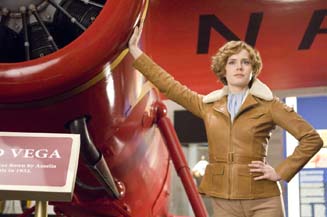Chapter Two:
Summer Scorcher 2009
By Brett Beach
September 30, 2010
Hanks is given remarkably little to do other than connect the dots of the conspiracy and react to the increasingly preposterous developments. I don’t consider the story offensive enough to be blasphemous. Indeed, with the revelation that the character played by Audrey Tautou is indeed the last living descendent of Jesus Christ, and has been marked for assassination by an orphaned albino hit man illicitly sanctioned by the church, my first thought was “Wow. Amelie is filled with the Christ love. Literally.” At its heart, The Da Vinci Code ultimately suffers from a seeming desire to remain implacably faithful to the source material and choosing to play down - Ian McKellan’s campy supporting turn aside - the ludicrousness of its events. At the time, a lot of critical tongues wagged about the state of Hanks’ hair, which generally strikes me as a petty road to tread. In this case, however, the dour sprawl of the two and a halfhour film (nearly three hours in the Blu-Ray extended cut that I have not seen) is given an apt metaphor in Robert Langdon’s sad and shaggy locks.
December of that same year saw the release of Night at the Museum. Also based on a popular (children’s) novel, it launched with a decent $30 million in the weekend before Christmas and then played like gangbusters thanks to the magic of what we at BOP term the “12 Days of Christmas” effect, earning $163 million by the end of that stretch and then tacking nearly another $100 million before it was out of theaters six months later. It undoubtedly made a lot more than it would have if released in, say, the summer (more on that shortly) but positive word-of-mouth added a lot to the coffers as well. Museum takes a great premise for the kids - what if a museum’s exhibits came to life at night? - and throws adults a dinosaur bone in the form of another of Ben Stiller’s patented turns as a well-meaning but awkward shlub (failed inventor turned security guard Larry Daley) at the center of the F/X storm. Museum is a pleasant diversion but it also feels like it’s chomping at the bits to be just a little more unrestrained and nutty. Given that Owen Wilson, Robin Williams, Steve Coogan, Paul Rudd, and Ricky Gervais are in the cast, restraint should not necessarily be the operative word.
I wouldn’t have thought that Angels & Demons would find a way to succeed where The Da Vinci Code faltered, especially since it shares the same lead actor, director, screenwriter, cinematographer, composer, and editors (to name but a few) and is based on the first novel in the series of Langdon adventures by author Dan Brown. Heck, there is even another freelance hit man who once again handles the dirty work for his squeamish superiors before being spectacularly offed. Instead of treating this as a prequel or even really a continuation of the first film (outside of a few offhand references to an earlier “adventure”), Hanks, Howard, et al plunge full steam ahead just as they did in the first film, making this at heart a sequel to what was a sequel to begin with. (Based on the evidence in the films, I could tell you almost no cold hard facts about Langdon, but a lot about his character.)
Langdon is once again summoned for help on a symbol-laden case that ultimately amounts to a whirlwind tour of Rome’s finest architectural creations crossed with Extremely Violent Deaths of Those in the Running to be the Next Pope. Most of Angels & Demons takes place over a four-hour period. With an incrementally tighter time frame than the first film, even the lulls in action don’t feel listless. What does emerge subtly in between the uncovering of clues and epic gunplay in church pews is a portrait of a spiritual skeptic who finds himself on the verge of a slightly different answer to the question “Do you believe in God?” than he has ever allowed himself to consider. The familiar Hanks persona - intelligent, self-lacerating, and slightly glib - is allowed more breathing room here than the first time around and it makes Langdon more engaging. It also helps that he seems more physically engaged in the action and the denouement.
Continued:
1
2
3
4
5
|
|
|
|

![]() Tweet
Tweet
![]() Print this column
Print this column



